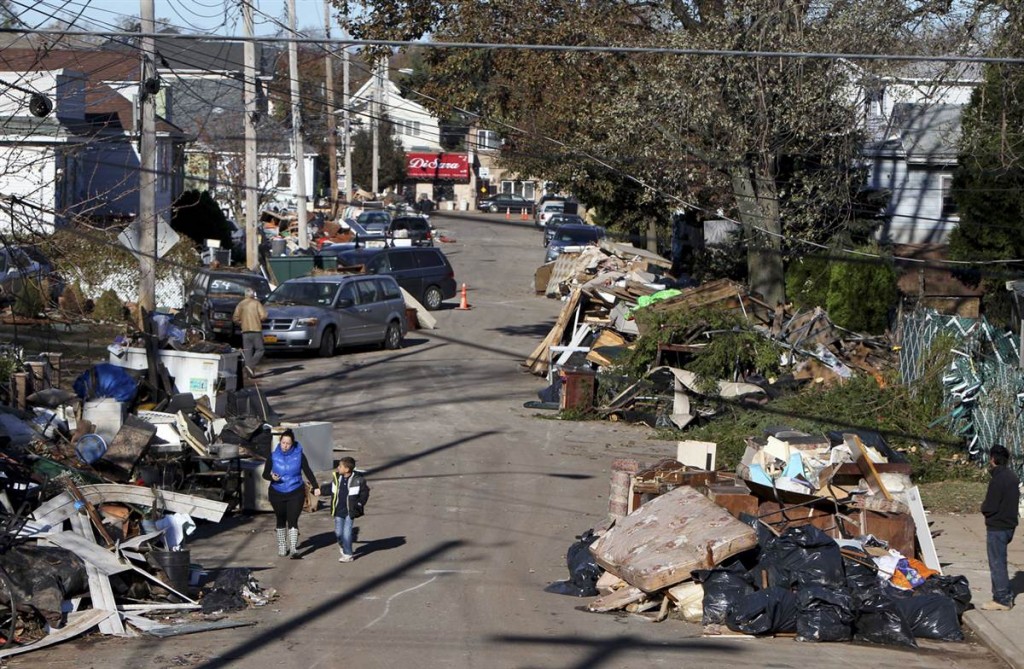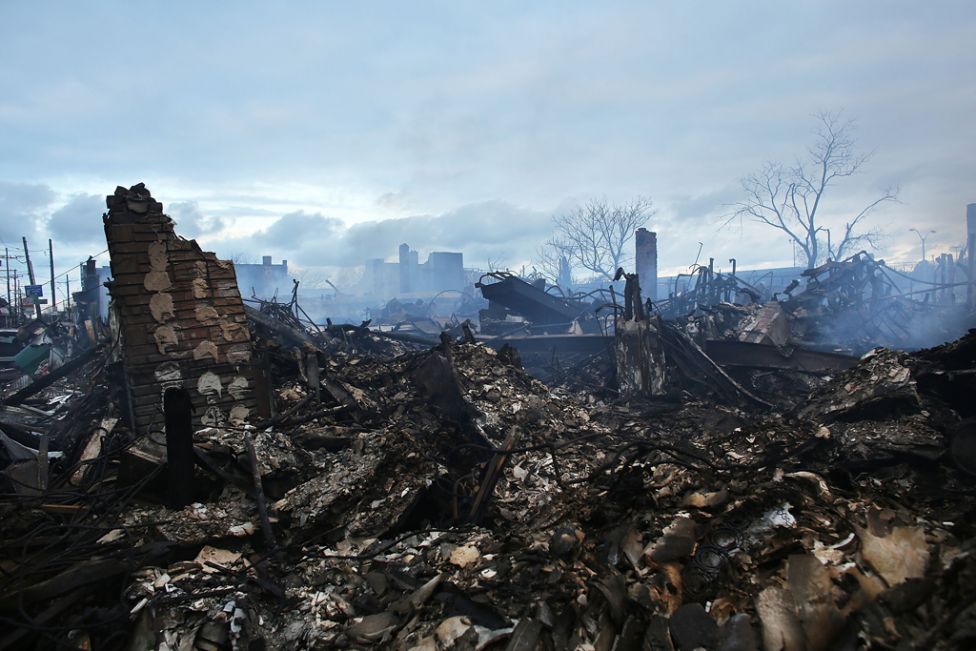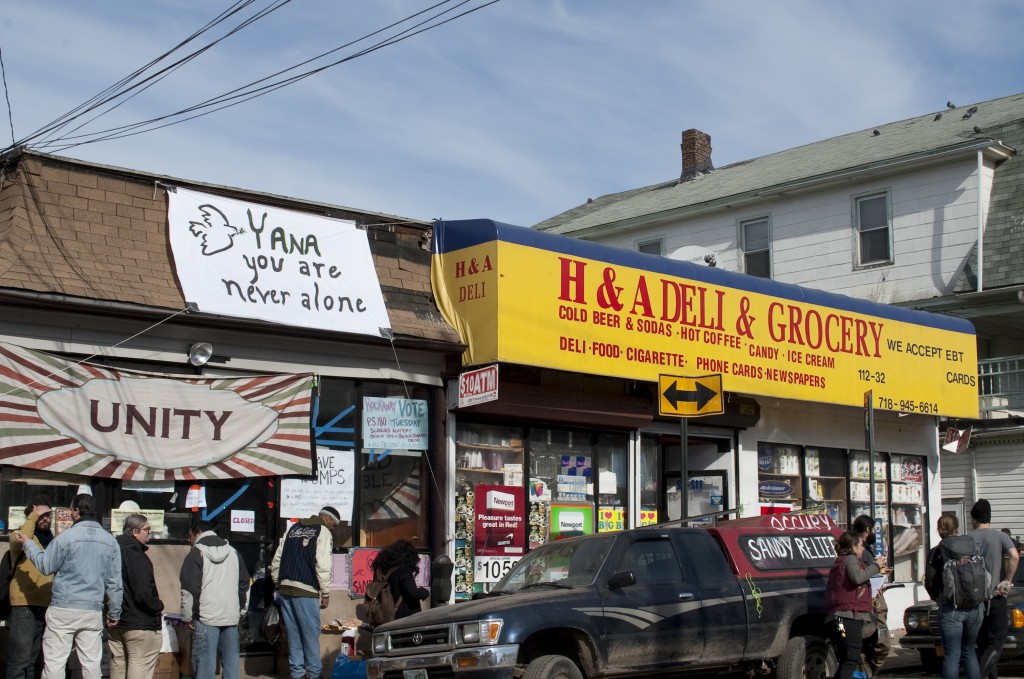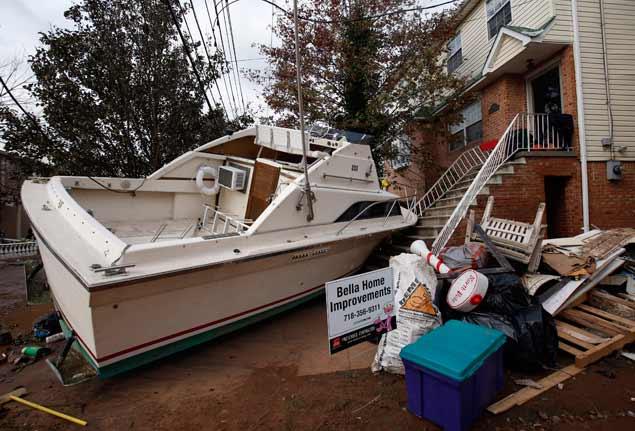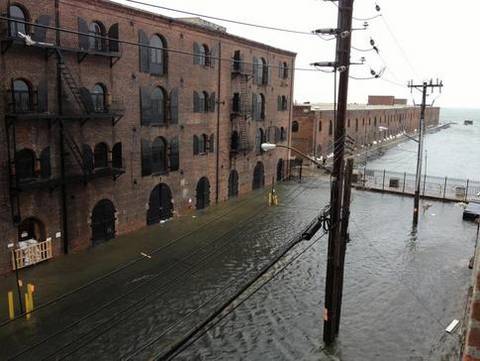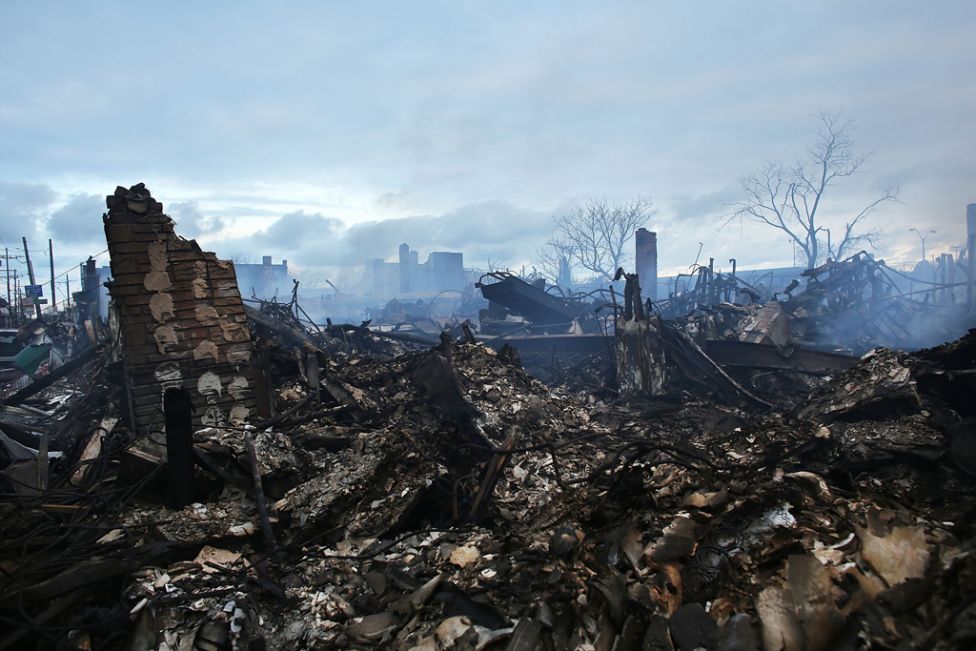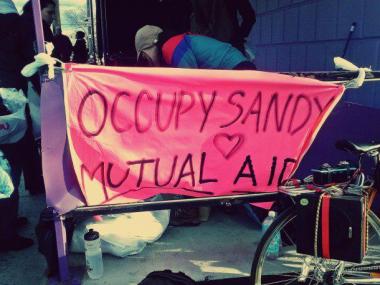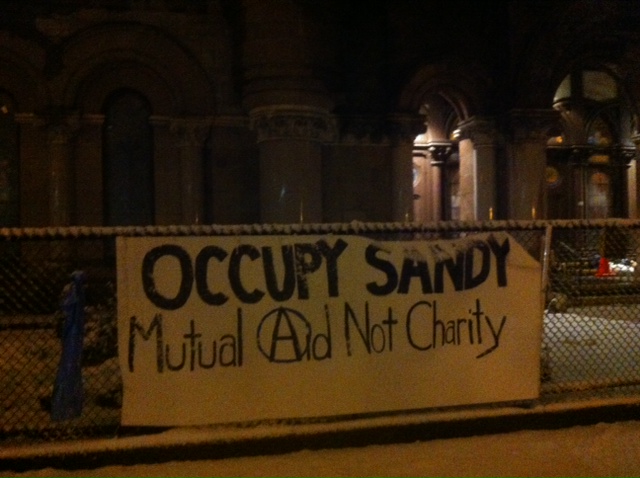Introduction
This report is a preliminary and living document highlighting the economic effects of Hurricane Sandy on New York City. It examines how the use of loans as the main form of “aid” to disaster-impacted communities is not effective at addressing individual or community needs. Further, the use of loans may lead to disastrous longer-term economic consequences for the impacted communities.
Although Hurricane Sandy was the first “Frankenstorm” to hit New York City, in recent years climate disasters have become a regular sight on the evening news. From Hurricanes Katrina and Irene to Midwestern droughts and wildfires in the Southwest, many communities are facing these types of crises all across the country. As our climate has changed, the burden of the cost of disaster has also been shifting. Individuals are now expected to shoulder relief expenses that used to be shared publicly. Victims are faced with long-term, unexpected economic consequences as well as displacement from the communities they call home.
This report was compiled based on observations made at a community meeting in Midland Beach, Staten Island on November 18, 2012, as well as on interviews with Federal Emergency Management Agency (FEMA) and Small Business Association (SBA) representatives, legal assistance volunteers, volunteer relief workers, local business owners and community members throughout New York City. Data was drawn from newspaper articles, statements from advocacy organizations and official reports. Download the full report.
Findings
- The economic costs of the disaster are placed on individuals. Federal aid programs require victims to first apply for loans before qualifying to apply for FEMA aid.
- “Aid” programs favor those who can take on debt. Preexisting inequalities are further exacerbated by this form of aid.
- Federal programs are inflexible and fail to meet even basic needs of affected individuals and communities.
- Relief options are not clearly communicated or well understood. Policies are so complex that even lawyers are confused and are “learning as they go.”
- Mold is at a crisis level. Residents will not receive FEMA aid to pay for the mold remediation necessary to make their properties even temporarily livable.
Federal Responses to the Disaster
Implementation of federal disaster services in New York City reveals a policy whereby government responds to national disaster by transforming economic consequences into long-term, individual financial burdens. Most Americans believe that FEMA will be there to help in the event of a disaster. However, the vast majority of FEMA’s resources and efforts are spent on public assistance grant programs that provide infrastructure restoration. Individual victims of disaster are mostly offered personal loans to help them “get back on their feet.” Although these loans might seem good on the surface, they have many features of predatory subprime lending techniques and ultimately make long-term financial burden the precondition for “recovery.”
There are three main sources of financial support being offered to Sandy victims: insurance, grants and loans. Federal support is only available once private insurance has been exhausted.
Insurance
Many residents of New York City’s coastal communities believed they had insurance that would cover them in the case of a severe storm. However, for a variety of “fine print” reasons, frequently these claims are being denied.
In some cases denials hinge on whether the storm was officially classified as a hurricane or a tropical storm and by whom. While FEMA classified Sandy as a hurricane, the National Hurricane Center of the National Weather Service declared Sandy a tropical storm at 7 PM on October 29th, an hour before it hit land. In cases where homeowners did not have hurricane insurance, many are being denied coverage by insurers who are classifying the storm as a hurricane. In other cases insurers are denying coverage because, though hurricane insurance covers damage from wind, it does not cover damage from flooding due to storm surge.
Insurance policies are typically written with “anti-concurrent causation” clauses that are intentionally difficult to understand. These clauses allow insurers to deny coverage even when a single exclusion is accompanied by inclusions, for instance when a home is destroyed by fire, wind and flood, but the homeowner did not carry flood insurance, the claim can be denied. In an attempt to prevent denial of claims in areas such as Breezy Point, Queens, where 111 homes were destroyed by fire, the Consumer Federation of America issued a statement demanding that elected officials in impacted states block the use of these “ACC” clauses. Due to the denial of numerous claims related to Hurricane Katrina because of these clauses, advocacy groups have worked to remove them.
“We believe that additional clarity is needed and can be provided by the New York Department of Financial Services. We call on state regulators to take action to help New Yorkers whose fire- and wind-related insurance claims payments are at risk of denial due to an unfair and legally unclear clause buried in the fine print.” Robert Hunter, Director of the Consumer Federation of America
Approximately 70% of New York residents living in flood zones do not have flood insurance. This type of insurance is costly, frequently only available through FEMA’s National Flood Insurance Program, and many residents mistakenly believe they are covered by homeowner policies and federal disaster assistance.
In areas that are prone to flooding, FEMA requires homeowners with federally backed mortgages to carry flood insurance. This insurance is guaranteed by the government but provided by private insurers that make on average one billion dollars a year in premiums in exchange for selling and servicing these policies. Private insurers take on absolutely no risk as the program is backed by taxpayer dollars.
Grants
FEMA offers two categories of services for disaster victims: public assistance and individual assistance. Public assistance consists of repairs to infrastructure such as bridges, roads and hospitals. 75% of aid comes from the federal government and 25% from state government. According to a FEMA representative, municipalities must work out arrangements for funds through their state government.
FEMA funds for public assistance can be passed through public agencies, nonprofit organizations and local communities, including community boards and local governments. Organizations must apply for funds through FEMA project officers. There are two broad categories for repairs: emergency work (including debris removal) and long-term work that rebuilds infrastructure to previous standards.
Individual assistance programs include grants for temporary housing, grants to restore homes to temporarily livable conditions, and grants for major repair of homes. Many New York City residents report having been offered FEMA grants to cover personal housing costs due to displacement. Residents consistently report grants of $3000 for temporary living costs, although the program maxes out at $31,900, according to a representative from Staten Island Legal Defense Services.
The next tier of FEMA program grants is only accessible after the homeowner, renter or business applies for a Small Business Administration (SBA) loan. According to representatives from Staten Island Legal Defense Services, if the applicant qualifies for a loan, they are not likely to be provided further FEMA aid. If the applicant is denied a loan, they may qualify for a FEMA grant for home restoration and repair.
Loans
New York City residents are being offered three kinds of disaster loans through FEMA and the SBA: home disaster, business physical disaster, and economic injury disaster loans. Home disaster loans are offered for repair and replacement of damaged real estate and personal property. Renters are eligible for personal property losses including automobiles. Business physical disaster loans are made for repair or replacement of property owned by a business including real estate, inventory, supplies, machinery and equipment. Economic Injury loans are offered to businesses in need of working capital to meet financial obligations that they cannot meet as a result of the disaster.
According to the SBA fact sheet on disaster loans, loans are made based on “credit history.” A representative from the SBA clarified this as “creditworthiness” and stated that credit score would not be an overwhelming factor. According to the representative, 50% of applicants qualify for these direct loans. Direct loans are direct from the treasury and not commercial bank loans.
The fixed interest rates for these loans vary between 1.688% and 4.0% if the applicant does not have “credit available elsewhere.” This means that only in the case that an applicant could not qualify for credit through a commercial bank would favorable interest rates be offered. In the event that an applicant could qualify for credit at a commercial bank, then the range is from 3.375% to 6.0%. The SBA fact sheet states the difference in interest rate as required by law. The SBA does not explain how it evaluates whether an applicant could practically obtain credit elsewhere.
The loan terms are a maximum of thirty years for individuals and seven for businesses. Home loans are capped at $200,000 for repair of property and $40,000 for personal property replacement. Business and economic injury loans are capped at $2 million. Insured losses, boats and recreational vehicles are excluded, and antiques and collections are eligible to the extent of functional value only. Applicants are required to pledge any available collateral.
Businesses are also able to apply for loans through the partnership between New York City and Goldman Sachs. These loans cap at $25,000 and are set at 1% interest. No payment is required for six months but loans must be paid in full within twenty-four months.
Even a month after the storm, many New Yorkers are only beginning to apply to the SBA loan programs. The small business application is reported to be at least thirty pages long. Applicants are reporting that the forms are difficult to complete, because flooding destroyed much of the required paperwork. Furthermore, many need assistance in filling out the applications, which are not self-explanatory. Although FEMA representatives at a community meeting in Midland Beach, Staten Island, reported the turnaround time as seven to ten days, others report a two-week turnaround. After a decision is made on a loan, residents may then apply for second tier FEMA funds.
“Of course, like most businesses down here, we have to completely rebuild. That means gutting our space and starting from scratch. The cost of this endeavor will top $50,000—and as most of us have found, floods aren’t covered by our insurance. And there is no FEMA money for small businesses other than loans, and it’s hard to take on more debt and face those payments when you don’t know when you’ll be able to reopen.” Leisah Swenson, co-owner of Home/Made Restaurant in Red Hook
In spite of the reality of having a home or business destroyed, the SBA representative for Midland Beach, Staten Island, bragged that they lent over $6.8 billion for Katrina victims. Of course, the agency has been heavily criticized for its work with Katrina victims. In fact, 55% of applicants were denied loans, and only 60% of the approved money ever reached the applicants.
Although the $6.8 billion number is contested and is probably closer to $6.1 billion, more serious allegations include economic and racial disparities among those who received any help at all. Since the basis for assistance is a loan program, predominantly white, wealthier areas received a significantly greater share of FEMA/SBA resources.
As long as qualification for help after a disaster is based on financial status, there is no reason for this to change. Furthermore, it is common for coastal properties in flood zones to be substantially lower in cost than coastal properties on higher ground. This means that middle and lower income communities tend to suffer the most.
Although the terms of these SBA loans are outlined on a fact sheet, the SBA representative described them inaccurately at a community meeting. When members of the community asked how SBA loans would impact their FEMA applications, their questions were evaded. It was not stated clearly that filing an application for an SBA loan was a requirement in applying for FEMA aid.
Further, at the Midland Beach November 18 community meeting, neither the SBA nor FEMA representatives explained the loan terms or the likelihood of applicants receiving either grants or loans. The SBA loan program was presented in positive terms by an enthusiastic representative. The representative only stated the lowest available interest rate, and was only willing to answer questions privately. Both FEMA and SBA officials used “insider” language that seemed designed to confuse and that community members could not understand.
Although the offering of these loans is presented as benevolence on the part of FEMA, Sandy victims have little choice but to apply for them. Homeowners typically owe on homes that are now worthless. William Kruger puts it this way: “Our values have dropped significantly. My real estate agent, who sold me the house just five years ago, was always saying ‘Whenever you want to sell, just let me know and at worst you’ll break even.’ I called him the other day and he said ‘Not now—you can’t even give it away.’ So we’re basically stuck. A lot of people are in the same position. So they’re forced, basically, to rebuild whatever is left.”
By only offering loans to already struggling homeowners, FEMA and the SBA shift the burden of disaster to individuals and send profit to the loan servicers. Although the vast majority of Americans believe that federal aid will be there for them if they are the victim of a disaster, in reality, the only available aid is the opportunity to take on more debt.
There is little real choice in taking on these loans, and they are granted based on opaque and questionable credit standards. With high unemployment rates, it’s easy to see how loan-based “aid” could precipitate a second round of crises in impacted areas, as many residents will be left on their own.
Further, because the SBA holds real estate as collateral against these loans, they are often difficult, if not impossible to get out of. Since many homeowners were already strained by “underwater” property prior to the storm, and since properties have now depreciated beyond measurability, homeowners have no way out of these properties other than foreclosure. The only practical option is to take the chance on taking on more debt.
Who Will Pay for Post-Hurricane Sandy Reconstruction?
The communities in New York City that were most impacted by the storm lie along the coastal regions of Manhattan, Brooklyn, Staten Island, the Bronx and Queens. The communities are diverse and vary widely economically, ethnically and racially, with the lowest median income in Coney Island, Brooklyn and the highest in Midland Beach, Staten Island.
Housing in these communities ranges from the multi-family high-rise buildings of the New York City Housing Authority (NYCHA) “projects” to single family beachfront dwellings. In addition to homes, there is a diverse array of businesses in the impacted areas ranging from large supermarket chains to small one-owner shops.
When we examine how the storm impacted these communities, we can see that the common complaints about FEMA’s response as both slow and inadequate are due to the agency’s focus on distributing the costs of disaster to individual victims based on and through their ability to take on debt, rather than distributing the costs across the public. The focus on lending moves money from the victims of disaster into the hands of the loan servicers who make $1 billion in profit annually off of these loans.
All communities are reporting numerous problems ranging from electrical outages, with a domino effect of no heat or water, to total destruction of buildings to severe damage due to flooding resulting in hazardous mold growth. The city has not reported on potential toxins in the flood water, however many residents have raised concerns and there are numerous water treatment plants in the impacted areas.
Throughout the beachfront communities of New York City, residents have stated that they did not feel the warnings were adequate. Many hold the city government directly responsible for the number of casualties and loss of personal property. In spite of a mandatory evacuation order, many residents did not leave. Some were unable to leave due to physical restrictions. Others felt that they had no place to go. Others state that they did not understand the storm to be different from previous storms that hit the area, and that there was a “boy-who-cried-wolf” effect city officials failed to overcome.
When specific needs and composition of individual communities are taken into consideration, the reasons that the federal approach to disaster aid falls short become clear. This section will highlight several of the most impacted communities and show why a “one sized fits” all approach that seeks to distribute the cost of disaster to individuals fails.
Midland Beach, Staten Island
Midland Beach is a middle class community of just over 14,000 residents in Staten Island, New York. Prior to the storm, 56% of home values were between $183,000 and $365,000 and 30% between $366,000 and $549,000, with the median at $385,000. Since 1990, homes saw over a 100% appreciation rate. Rentals average $1,245 per month.11 The neighborhood is one of the most diverse in America with 30.7% of residents of Italian ancestry, 20% of Irish ancestry and 9.3% of Puerto Rican ancestry. 3.3% of residents speak Russian in their homes. Over 16% of residents were born outside of the United States. 17.1% of children in Midland Beach live below the poverty line, which is a greater percentage than 58.1% of US neighborhoods. Median household income is $71,000.
This tight-knit community had the highest concentration of Sandy-related deaths in the United States. The rising water of the storm surge reached as high as over fourteen feet with reports of the surge overtaking fifteen-foot barrier walls on Staten Island. According to Father Diaz of Saint Margaret Mary Church, 95% of his parish has been impacted by the storm.
The majority of those impacted had homes either red- or yellow-tagged by FEMA. A red tag indicates that the home should not be entered, and a yellow tag indicates that the home may be entered only at your own risk. Many of the homes have sustained severe structural damage. All of the homes have sustained substantial water damage, including debris and toxins left behind once the water receded. Residents are currently conducting mold remediation at their own expense and most frequently without professional help. Regardless of the status of the home, the burden of cleanup has been placed on the homeowner and volunteers.
Some community members expressed concern that they were unable to find out if their homes had been designated as being in a CBRA (“cobra”) zone. CBRA stands for Coastal Barrier Resources Act. This act, passed in 1982, prohibited indirect or direct federal dollars from expenditure in zones considered prone to flooding.
It took FEMA days to show up after the storm, provoking an angry admonition from Staten Island’s borough president. When they finally showed up, they provided very little of the resources most needed to initiate a process that might eventually return the community to normal. Instead of using their enormous resources to provide hot meals, they provided only freeze-dried food and bottled water. Instead of going where the people needed help, they stationed themselves in schools and parking lots, expecting the elderly and infirmed to travel to them.
While the residential community was clearly in need of resources such as physical help with the massive job of cleanup and ongoing financial support to begin the process of recovery, they were only offered debt.
Red Hook, Brooklyn
Red Hook is a diverse and gentrifying neighborhood in Brooklyn situated along the Hudson River with a population of about 10,228. In recent years, gentrification of Red Hook has taken hold with an IKEA and a Fairway gourmet food store opening their doors. For several years prior, upscale art galleries, restaurants and bars had opened in the neighborhood. Red Hook is also home to New York City’s largest housing project, which contains some 2,878 units. According to NYCHA, Red Hook Houses was among sixty-two projects affected by the storm. The neighborhood is not serviced by subways but connects to neighboring communities by NYC buses and water taxis.
The effects of the storm brought weeks of blackouts for residents and businesses and massive damage to homes, businesses and public spaces. People living in the high-rise project housing development were faced with pitch-black stairwells that reached as high as fourteen stories—especially hard on the elderly and infirmed. Extensive flooding took over the whole community with flood levels rising over seven feet in some places and closing the Brooklyn Battery Tunnel for weeks. NYCHA confirmed that 3,600 Red Hook Houses residents were without power, and over 4,000 residents had no heat and hot water.
“The water, said New York Water Taxi employee and neighborhood resident James Caldwell ‘went to the Brooklyn Battery Tunnel intakes and all the way to the Gowanus.’”
Along Van Brunt Street, the main retail strip, businesses were flooded and inventory destroyed. The rising real estate market of the mid 2000s brought numerous boutique small businesses into the neighborhood, but in recent years they have been hit with rising rents and decreased business activity.
The majority of those impacted by the storm were either small business owners or residents of Red Hook Houses. Residents complain that FEMA is more focused on local businesses than on residents.
“Angel Ylufo, who lives in a high-rise project housing building on Dwight Street, expressed frustration with the state and allocation of recovery efforts in Red Hook: ‘I’ve got no power, no water and can smell sewage in my building and there is definitely more attention to the local businesses than for us in the projects. I’m all for local business, but what about the rest of us citizens who are living here?'”
However, local businesses aren’t thrilled either. Many are still waiting to see if their loan applications will be approved or not, but do not see taking on additional debt as a solution for the disaster. Instead, many have started crowd-source funding pages to raise money for repairs, stating that if the condition of reopening is debt, then they cannot afford to reopen.
Of course, the disparity between attention to residents and attention to business owners is the natural result of FEMA’s policy, which reveals itself as less focused on providing true relief to those suffering massive losses in their communities than on generating profits for the elite through debt. In this scenario, only those who are likely to be creditworthy are helped in any way at all.
Coney Island, Brooklyn
Coney Island is home to a sizable share of Brooklyn’s public housing and a large percentage of the population is housed in high-rise buildings. 79.7% of the area’s residents are renters. One of the poorer neighborhoods in Brooklyn, the household median income of $22,315 is nearly half that of the borough on the whole, and more than 40% of Coney Island’s children live below the federal poverty line. Home to a large population of retirement-age seniors, over 22.3% of Coney Island’s residents are sixty years of age or older, and a significant proportion of the population is composed of foreign language speakers of Chinese, Spanish, French and Russian.
At the height of the storm surge, Coney Island was completely submerged in floodwaters as the surrounding bay and sea met. As elsewhere, FEMA and the Red Cross were incredibly slow in arriving, and while other neighborhoods have begun the long process of recovery, the process in Coney Island is anemic at best as residents continue to cope with inconsistent power, heat and hot water, even a month after the storm hit.
Once the storm passed, a major need was for the elderly, disabled and ill to be identified and provided with basic necessities. Among many reports from the area, no such direct effort by city, state or federal agencies or even the Red Cross was noted in the weeks immediately following the storm. Many residents spent weeks in dark, cold apartments without food, water and prescribed medical treatments.
As with many low-income neighborhoods and areas where public housing is prevalent, much of the area has been underserved by supermarkets and drug stores. Many of the bodegas were flooded and looted in the wake of the storm, leaving residents without access to even a bare minimum of necessities like food, cleaning supplies, baby formula and diapers.
Boilers, electrical panels and laundry rooms in much of the area’s projects were housed in basements, and were destroyed by flooding. Many of them are now being heated and powered by mobile generators and external boilers. It will require a massive reconstruction effort to permanently restore heat and electricity. Reports of poor air quality and sickness are common due to fuel leaks and residents using stovetops to heat their homes. In apartments on the ground floors of buildings that suffered flooding, residents sustained significant damage to appliances and personal possessions, and mold is increasingly an issue. Those who have insurance are hesitant to discard items that have yet to be documented for insurance purposes. The lengthy, confusing and intrusive loan application process FEMA requires as a precondition for aid is likely to provide a significant barrier to the majority of uninsured renters who’ve suffered personal property damage.
FEMA’s presence finally began to be visible in the community over a week after the storm hit, but even then their trailer was located in the historic far west end of Coney Island, far from the majority of NYCHA housing in which many elderly and disabled residents were trapped. Despite a significant population of Russian speakers, FEMA materials were not available in Russian.
The Rockaways, Queens
The eleven main communities that comprise the Rockaways—Arverne, Bayswater, Belle Harbor, Breezy Point, Far Rockaway, Hammels, Neponsit, Rockaway Beach, Rockaway Park, Roxbury and Seaside—are tremendously diverse and vary greatly in terms of income levels and ethnic makeup. Median incomes among the various communities range from the mid $25,000 range to the upper $50,000 dollar range. Communities of many ethnic ancestries are represented throughout the Rockaways, including significant populations of Irish, Italian, Puerto Rican, West Indian, Haitian and Jamaican descent. The area is widely known as a summer attraction, with the well-known beach Riis Park accessible by bus. The entirety of the Rockaways was hit hard, but different sections are the focus of FEMA’s resources. It is easy to observe that FEMA’s efforts are primarily in the higher-income area west of 116th Street, where repair to the beachfront has already begun. There is little to no activity to the east, where middle and lower income people of color live.
Again, this reproduction of inequality is a necessary and unjust effect of a federal disaster relief agency’s use of debt as its primary tool. Those who are viewed as already most resourced are able to get out of debt and recover, whereas those who are less resourced are either not offered any path to recovery or moved from the crisis of natural disaster to the crisis of debt that can’t be repaid.
Ironically, climate change has a disparate impact on middle and lower income communities. In particular, African Americans, who have been among those most impacted by this disaster, make a significantly lower impact on the climate than other groups. Climate disaster is likely to strike increasingly. As it stands, it is the middle and lower classes that pay dearly for these disasters, while producing enormous profits for the financial service industry.
Learning from Past Disasters
Only days after the storm, proposals for deregulation and privatization of areas affected by Sandy began to be discussed: FEMA should turn NYC’s most devastated neighborhoods into free-trade zones exempt from typical regulations and taxes; public work projects should be managed exclusively as for-profit and outsourced public-private partnerships; and pro-union rules should be thrown out in order to speed up reconstruction.
Policies like these are typically too extreme or unpopular to be implemented democratically. It’s when major economic or environmental disaster provides a shock strong enough to disorient that the democratic process can be avoided and these policies get pushed into motion. While those who live in and around affected communities see destruction, suffering and loss, others have systematically come to regard such events as opportunities. Time and time again we see these moments of crisis exploited to shift the economic burden, reconfigure structures of government, and direct resources away from those who are most in need.
Case Study: Hurricane Katrina
In 2005, Hurricane Katrina provided a clear example of how unjust policies can play out in the aftermath of disaster. The indifference and neglect from all levels of government in response to the storm profoundly shocked the nation and the world. Overall, the relief effort revealed a widespread transfer of money and resources that moved from taxpayers to the federal government to corporations. Through the redevelopment of the city, new policies were put into place that exploited the victims of the hurricane a second time around.
By 2010 the population of New Orleans was 30% smaller than before the hurricane.
Katrina destroyed nearly 51,700 housing rentals. More than 29,000 affordable-rent units vanished. It was estimated in 2007 that homelessness had roughly doubled to about 12,000 people. Over 5,000 families had lived in public housing before Katrina, but by 2008, the Department of Housing and Urban Development (HUD) sought to replace public housing with mixed-income housing, using ineffective vouchers, often denied by landlords, to subsidize low-income families. HUD opposed a congressional proposal to replace the destroyed public housing units, even though it was the most economically viable alternative. In this process, entire public housing complexes that weren’t even damaged by Katrina were demolished.
“‘The truth is that only the wealthy moved through the system easily,’ said Gale Martin a former SBA loan officer “If you were of a certain income, we funded you first, which is not the way the system is supposed to work.” Martin contended that contrary to the SBA mission to especially help people who didn’t always have the means to rebuild, applicants with higher credit scores and bigger incomes were cherry-picked for processing first because those files could be closed quicker.”
In terms of racial disparities, SBA approved 66 percent of loan applications in predominantly white, suburban areas but in contrast approved only 42.1 percent in adjacent areas with comparable median household incomes in predominantly black sections of the city. In the end, overall 55 percent of homeowners and businesses that applied for SBA loans were turned away. A mere 60% of the loan money approved by SBA ever even reached its applicants.
Conclusion
Very early on in the 2008 financial crisis, while Americans were still reeling from an unprecedented economic disaster, a decision was quickly made that the massive debts and losses of reckless banks and investors were to be paid for by the American public, while the debts and losses of average Americans—homeowners, pension fund beneficiaries, those who lost their jobs and those whose prospects were permanently diminished—were to be shouldered by those same individuals. Many would argue that such an arrangement was unfair, but decisions as to who bears the costs of a crisis—whether it’s a financial crash, or a hurricane—are often made as the crisis is unfolding, while those with the fewest resources and access to power are struggling to process what just happened. The result is rarely good for the 99%.
Here in New York, as our communities struggle to come to terms with the mass destruction, suffering and loss of life left behind by Hurricane Sandy, decisions are already being made as to who will bear the costs. Now that these costs have become clear, the question remains: Will they be borne by a billionaire mayor and his close friends in the real estate industry who rezoned and developed the coastline at an unprecedented pace, even as the Army Corps of Engineers ranked New York at the top of the list of cities most vulnerable to a storm surge? Will the federal government that refused to make the necessary infrastructure investments to protect us pick up the tab? Will the private insurers who accepted premiums year after year step up to pay for the damage they led us to believe they would cover? Or will those costs be borne by the fossil fuel companies and their lobbyists who have done everything in their power to make sure that radical changes to our atmosphere continue at a rapid pace, making all of us more vulnerable to natural disaster?
As usual, it seems likely that the costs will be borne by the unfortunate individuals who found themselves in the path of a disaster that’s been years in the making—in this case the city’s residents. Rather than being offered the aid needed to restore their homes, those whose houses were destroyed are being pushed by FEMA to take on debts that will surely haunt them for the rest of their lives. Renters receive even less support in a system built to favor those who can take on debt. Residents of low-income housing, many of whom have been dealing with poor maintenance and deteriorating infrastructure in their buildings for years due to decreased federal spending and a revenue-strapped housing authority have needlessly suffered further due to federal and city loan-based relief efforts that don’t address their needs.
Debt is not aid. It would be cruel to offer a drowning person a 50 lb. dumbbell. Asking a person or family that has just lost everything to now take on $50,000 of debt and a lifetime of interest payments is not significantly more generous or helpful. Federal, state and city governments must do better.
Mutual Aid
For any community, anywhere in the world, mutual aid is fundamentally important in the wake of disaster. Contrary to the popular conservative economic doctrine that says human beings are naturally motivated by self-interest, we strongly believe that when members of our community are suffering, nothing could be more unnatural than to sit back and watch.
But mutual aid is not a selfless act. It’s an act of solidarity, done with the understanding that all of us are living in an increasingly volatile climate and have been collectively forced into a predatory debt system just to secure basic necessities like housing, education and medical care. In such precarious conditions, forming communities that care for each other and act collectively to achieve change makes each of us more secure. And in a city with such extreme inequality as New York, it’s mutually beneficial to all middle- and low-income families to prevent the displacement of yet another community where we can afford to live.
In the wake of Sandy, the vast majority of post-storm economic assistance has been provided by volunteers, coordinated by several umbrella groups including Occupy Sandy, CAAAV, People’s Relief, Occupy Faith, Rebuild and Recover and others who came together almost immediately to take responsibility for providing manual labor, tools, food and supplies, as well as the organizational skills necessary to manage complex operational systems. Nonetheless, victims of Sandy are in desperate need of the resources that centralized government agencies are created to deliver. Surely federal, state and city governments who went to great efforts to nationally coordinate a series of well-planned evictions of encampments to protect protesters from deteriorating sanitary conditions can muster the resources to coordinate a mold-remediation campaign in communities where mold is quickly becoming a genuine public health hazard.
In every case we’ve reviewed, mutual aid networks were on the scene days if not weeks in advance of federal, state and city run efforts, delivering needed care and support that in many cases official relief efforts have yet to step up and provide. In Staten Island, for example, Occupy Sandy Relief has created a central distribution hub at the Church of Margaret Mary at 1128 Olympia Blvd. This hub provides volunteers, hot meals, cleaning supplies, blankets, heaters and a variety of tools necessary for demolition work. It also acts as the central hub of the community and facilitates community meetings. Residents clearly see mutual aid as the main source of economic support for their recovery, and as a method of resisting debt. It’s high time government agencies stepped up to provide meaningful assistance to these communities as well.
In the meantime, we must continue to use the principles of mutual aid as we rebuild our broken homes and neighborhoods. We cannot let profits be the force that determines the future of our communities. We must demand a democratic planning process that acknowledges the importance of the common good and our shared humanity.
Resources ↓
Klein, Naomi. “From Aceh to Haiti, a predatory form of disaster capitalism is reshaping societies to its own design.” The Guardian, April 18 (2005).
Klein, Naomi. The Rise of Disaster Capitalism. Bonobo Films. Oakland, CA : PM Press (2009)
Klein, Naomi: Sandy’s Devastation Opens Space for Action on Climate Change and Progressive Reform. Democracy Now, November 15, 2012
Klein, Naomi; The Shock Doctrine : the Rise of Disaster Capitalism. New York, NY: Metropolitan Books/Henry Holt. (2007.
Kovach, Bill and Rosenstiel, Tom Doctrine, Shock. “The Rise of Disaster Capitalism. (2007).
Krugman, Paul. The Great Unraveling: Losing Our Way in the New Century “This is Not a Recovery,”.” New York Times (2010): 08-06.
Lewis, Paul. Disaster Capitalism Sums Up Mr Osborne’s Strategy. The Observer. (2010)
Light After the Storm – Local Churches Partner with Occupy Sandy in Grass Roots Relief Efforts. Info Shop News. November 17 2012.
Lord, Jerry Joseph. “The charging of the flood: a cultural analysis of the impact and recovery from Hurrican Ike in Galveston, Texas.” (2011).
Lotta, Raymond. Capitalism and Climate Change: When a Natural Disaster Becomes a Social Disaster. Global Research, November 10, 2012.
Loyd, Jenna M. Katrina: A Racist Disaster. Capitalism Nature Socialism 18.3 (2007): 122-129.
MacLeod, Gordon, and Jones, Martin. Renewing urban politics. Urban Studies 48.12 (2011): 2443-2472.
Marom, Yotam Occupy Sandy, From Relief to Resistance. The Indypendent. Nov 13, 2012
Michael Moore on climate change and Superstorm Sandy: “This is going to set the precedent” CNN. October 31, 2010.
Mitchell, Rick; Disaster Capitalism, or, Money Can’t Buy You Love Three Plays. Bristol: Intellect. (2011)
Monk, Katherine. Naomi Klein and Robert Redford Blast ‘Disaster Capitalism’. The Gazette. (2010)
Murphy, Jarrett. Bronx Bruised By Sandy’s Power. City Limits. October 30, 2012
Office of the Mayor. Mayor Bloomberg Releases Hurricane Sandy Federal Aid Request . November 26, 2012 No. 443
Pelling, Mark, and Dill, Kathleen. Disaster politics: tipping points for change in the adaptation of sociopolitical regimes. Progress in human geography 34.1 (2010): 21-37.
Perez, Michelle Salazar, and Gaile S. Cannella. “Disaster capitalism as neoliberal instrument for the construction of early childhood education/care policy: Charter schools in post-Katrina New Orleans.” International Critical Childhood Policy Studies Journal 4.1 (2011): 47-68.
Perry, Chris. Lakewood – A Natural Disaster Paradise. The Lakewood Observer. November 14, 2012.
Rohter, Larry. Shipping costs start to crimp globalization. New York Times . (2008).
Rozario, Kevin; The Culture of Calamity: Disaster and the Making of Modern America. Chicago, IL: University of Chicago Press. (2007)
Saltman, Kenneth J. Capitalizing on Disaster: Taking and Breaking Public Schools. Boulder, CO: Paradigm Publishers. (2007)
Saltman, Kenneth J. “Schooling in Disaster Capitalism: How the Political Right Is Using.” Teacher Education Quarterly (2007).
Samuels, Tatyanika. Bronx residents slowly but surely reclaiming their lives after SuperStorm Sandy damaged homes. Nearly a month after Sandy, Bronx faring better. The New York Daily News. November 25, 2012.
Schuller, M An Anthropology of Disaster Capitalism – unpublished ms.(nd)
Shabazz, Saeed. Dollars and Disaster. The Final Call. November 22, 2012
Srinivas, Nidhi. “Disaster capitalism and disaster managerialism: what recent earthquakes tell us about management.” 3 rd LAEMOS (2010).
Stanford, Jim. Why natural disasters are good for capitalism. Rabble.ca. November 5, 2012.
Stonich, Susan. “International Tourism and Disaster Capitalism.” Capitalizing on Catastrophe: Neoliberal Strategies in Disaster Reconstruction (2008): 47.
Vilensky, Mike. Party’s Over After Sandy. The Wall Street Journal/ NY Region. November 6, 2012.
Williams, Chris. Ecology and Socialism: Solutions to Capitalist Ecological Crisis. Haymarket Books, (2010).
Winterbottom, Michael; Whitecross, Mat; Cooke, Alex; Eaton, Andrew; Lewis, Avi; Klein, Naomi; O’Brien, Kieran
The Shock Doctrine IFC Films; Brooklyn, NY: KimStim, (2011)
York, Richard, Clark, Brett, and Bellamy Foster John. Capitalism in Wonderland. Monthly Review 61.1 (2009): 1-18.


